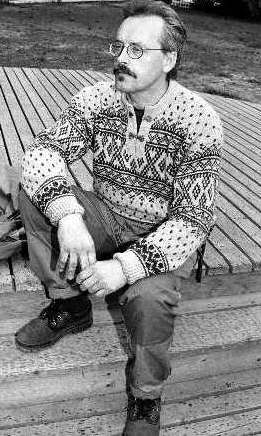
An historical work, entitled Sami, Reindeer, and Gold In Alaska by a
Tromso university professor Ornulf Vorren, has launched another
Norwegian author on a journey through Alaska and the Yukon this summer.
Novelist Dag Ove Johansen is searching for material for his his 13th,
book. Or perhaps it is more accurate to say, for his 13th through 19th
books.
Johansen, who has a contract with his Norwegian publisher for a series
of a half dozen volumes, laughs when he says the series might reach even
20 books.
And he has been covering enough landscape to almost fulfill such an
ambitious undertaking.
From Bodo, near his home in Holstad 200 kilometres above the Arctic
Circle in Norway, he flew to Oslo, Copenhagen and Seattle in late June.
Then he bused to Bellingham, Washington, to take the ferry to St.
Petersburg, and Juneau.
He flew to Whitehorse, Anchorage, Nome, and will fly back to Anchorage
again, before driving to Circle City, and Dawson City.
By the time he returns home July 23, Johansen will have a much better
idea of the terrain his characters must cover to re-enact the adventures
of two expeditions of Norwegian Sami folk who trekked to Alaska to herd
reindeer in the late 19th century.
And as for arriving here more than a century after the events he will
write about, the novelist will, no doubt, be able to reconstruct the
period in his powerful imagination.
Johansen is an old hand at traveling through time — 1894 and 1897? No
problem. He has frequently gone back 10,000 years, urged on by his
fascination with the Sami folk of Scandinavia, and their long, long
history.
That's not surprising, however, because the work of science fiction
writer Ray Bradbury launched the 50-year-old Norwegian teacher on his
own literary path more than a quarter century ago… a fact reflected in
the title of Johansen's 1974 collection of stories, T for Tramatura.
Meanwhile, the Norwegian's most recent volume for young people is
called, significantly, Tidskapselen, or Time Capsule.
In his teens, when his family lived next door to a Sami family, young
Johansen came to admire their philosophy and lifestyles which their
ancestors had been developing since they lived in happy isolation along
the Scandinavian north coast, cut off from the south by massive
Pleistocene ice sheets.
"We haven't treated the Sami very well throughout their (recent)
history," he says, echoing a sad fact of Canada's relation with its own
First Nations.
"In the 1700s, (the Sami) had their rights to the lakes and rivers, but
the government took them away."
However, the Sami now have their own parliament and great autonomy.
Fur traders arrived in northern Norway and exchanged alcohol for pelts.
The traders claimed to have no money, or tools to trade, only booze.
Eventually, however, the Sami managed to throw off that baleful legacy.
The Sami, like the Yukon's first peoples, had elegant, accurate, lovely
names for the geographical features of their homeland, names which were
often replaced by inappropriate, even ridiculous names by Europeans,
says Johansen.
But "the new maps are going back to the Sami," he says, triumphantly.
The novelist's own fictional Sami protagonists will be based on the
members of two parties of Norwegians brought to Alaska to lead relief
expeditions.
In the late 19th century, the aboriginal people of Alaska's northwest
coast were facing famine. Authorities decided that reindeer herds, like
those in Scandinavia, might bring relief.
The reindeer were brought in from Siberia, as were the first herders.
But those Siberian herders had a long history of bad relations with the
Inupiat of Alaska's coast and the experiment didn't work.
Then, someone hit on the idea of bringing in Sami herders from northern
Norway… with much happier results.
Some of those herders, who signed on for three-year contracts, were on
hand for two especially formative events in Alaska and Yukon history —
the Nome and Klondike gold rushes.
"Have you heard of the three lucky Swedes?" asks Johansen, referring to
the men who first found gold near Nome.
A century ago, Sweden controlled Norway, he explains, so in distant
North America Norwegians and Swedes were sort of seen as one and the
same.
In fact, one of the so-called "lucky Swedes" was a lucky Norwegian, a
Sami named Jafet Lindeberg.
Some of the 64 members of the second reindeer relief expedition also
found their way to Circle City, and to the Klondike, where the hunger
for gold led to a flood of immigrants and a widespread and more literal
hunger for meat.
Johansen felt very fortunate to be visiting Whitehorse at the time of
the Commissioner's Potlatch.
He has an understandable fascination with the Yukon’s First Nations, and
he needed to take two days off from his strenuous archival research to
just enjoy himself — which he did at the potlatch.
And the rain that fell intermittently during his stay in Whitehorse
didn't faze him much.
While the author lives above the Arctic Circle, the Bodo area has a much
warmer and much damper climate, thanks to ocean currents from the south.
Unlike Johansen, no Yukoners above the Arctic Circle can boast of
picking 11 buckets of plump apples from their own trees!
While none of Johansen's books are yet available in English, he is a
major believer in the possibilities of the world wide web and has made
good use of it to get his name and ideas out into the world.
(As a matter of fact, he says that planning this trip to North America
would have been impossible without the web.)
He maintains an impressive site, which can be reached at
Through the site, one can view lovely images of northern Norway, learn
about many of Johansen's literary colleagues, and about some of his
literary and philosophical mentors like Bradbury, Kurt Vonnegut and Knut
Hamsun.